This scrumptious Pozole Rojo (or posole) is a traditional Mexican stew laden with delicate pig pieces and hominy. As its name suggests, this meal has a brilliant hue thanks to dried Mexican chilies like guajillo and ancho chile peppers. An abundance of flavors, including onion, garlic, cumin, and oregano, combine to make this stew a flavorful powerhouse. To increase the ante, top with shredded cabbage, sliced radish, cotija cheese, and more!

I had my first taste of pozole when visiting San Diego, which is a boiling pot of Mexican food all over. Then, a few months back, while I was in Phoenix, I stopped at a restaurant called Gallo Blanco and had the most wonderful bowl of pozole rojo. Really, I still think about that occasionally. It was a little bowl with loads of cabbage and other garnishes on top that was clearly bright red. Then, with my spoon, I was able to uncover bits of beef and hominy corn by diving beneath the aromatic crimson liquid. You guys, I was so engrossed in the appetizer that I didn’t even realize I ordered tacos until the waiter brought them to me.
The Most Delicious Pozole Rojo
A typical Mexican stew or soup is pozole. To go further, there are two types of pozole: pozole blanco (white), where the broth is plain and devoid of color, and pozole verde (green), where the broth is spiced up with salsa verde, tomatillos, poblano peppers, and/or jalapeños. Lastly, there is pozole rojo, or red pozole, in which a mixture of Mexican red chilies is used to make the soup. The red chiles give the stew’s final product a touch of spice, smokiness, sweetness, and additional delicious flavor. Pork and hominy are unquestionably the two main components in a pot of pozole (or posole). But there are also variations that include chicken.

What Is Pozole (Posole)?
Pozole is a year-round dish in Mexico, although it is particularly popular during festivals and festivities such as Christmas and New Year’s. It’s among the most well-known and cherished foods in Mexico. The dried hominy used in traditional pozole would need to be soaked and cooked beforehand. The hominy bud would be removed from its shell and simmered until it was ready to be used in pozole. But we may omit that step because of canned hominy.
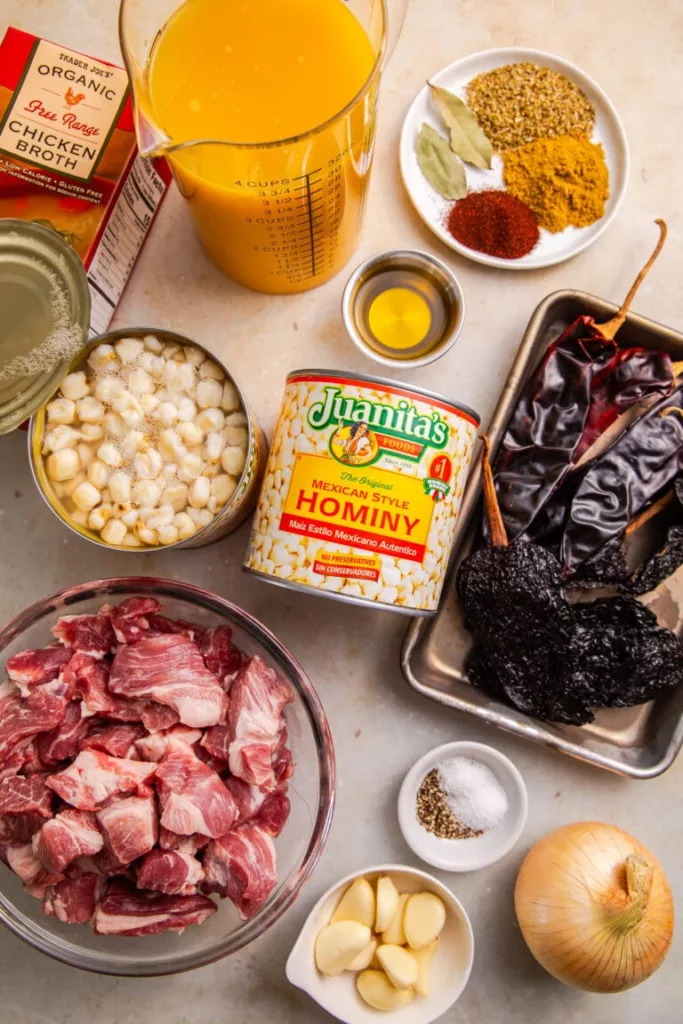
Ingredients Needed For This Pozole Rojo:
- Dried chiles: I use ancho and guajillo chilies from Mexico. The flavor characteristic of Guajillo chilies is fruity, smokey, and sweet. On the other hand, ancho chiles are dried, unripe poblano peppers with a sweet, smokey taste. It’s vital to remember that both chiles have relatively low Scoville ratings and are regarded as moderate to medium in heat strength. Thus, try not to be alarmed by the vividness of color! These dried chiles may be found in almost any Latin market or occasionally in the foreign section of your neighborhood supermarket.
- Oil: To brown the pork shoulder, I use olive oil.
- One of the key components is pork shoulder! Known also as Boston butt. Choose a pork shoulder that has been thinned down and well marbled.
- To season the pork as it is browning, use salt and pepper.
- Onion: One yellow onion, check for a hint of fragrance.
- Ten cloves of garlic, a huge amount of garlic. Yum.
- Spices: chipotle powder, oregano, and cumin (for a great kick).
- Bay leaves are a basic ingredient that give stews depth.
- I use Juanita’s canned hominy; be sure to rinse and drain your hominy!
- For adding body and flavor to the stew, use chicken broth.
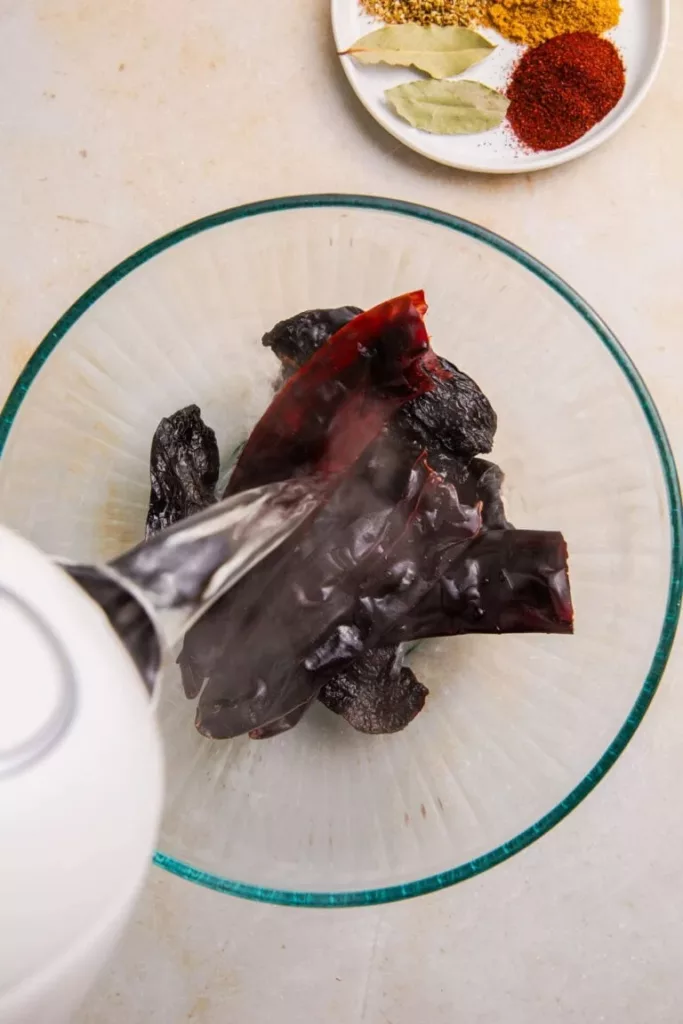

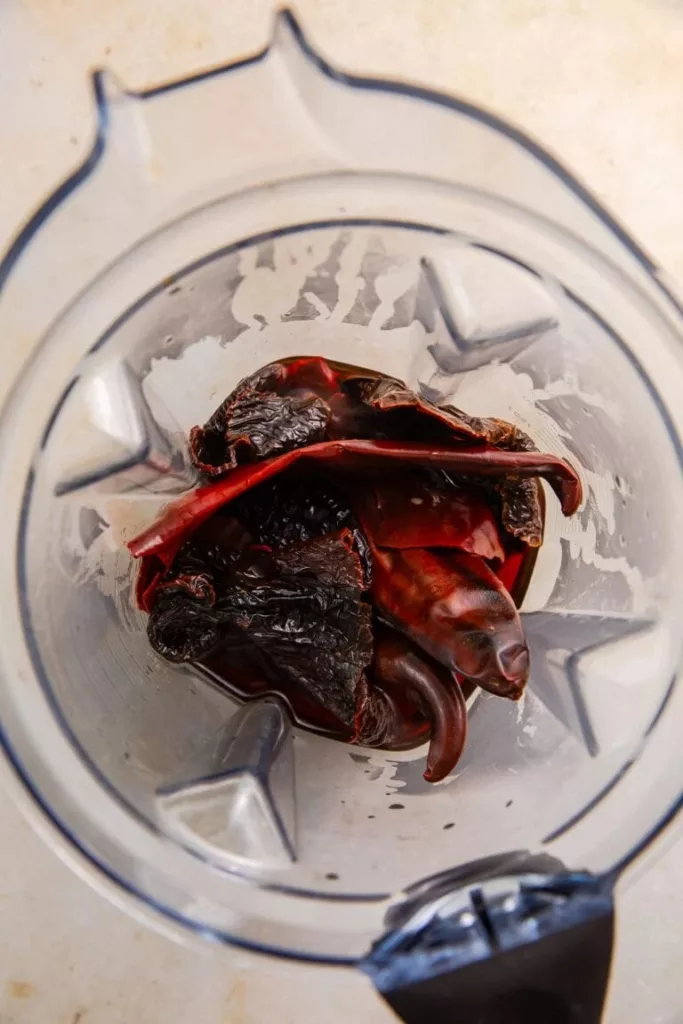
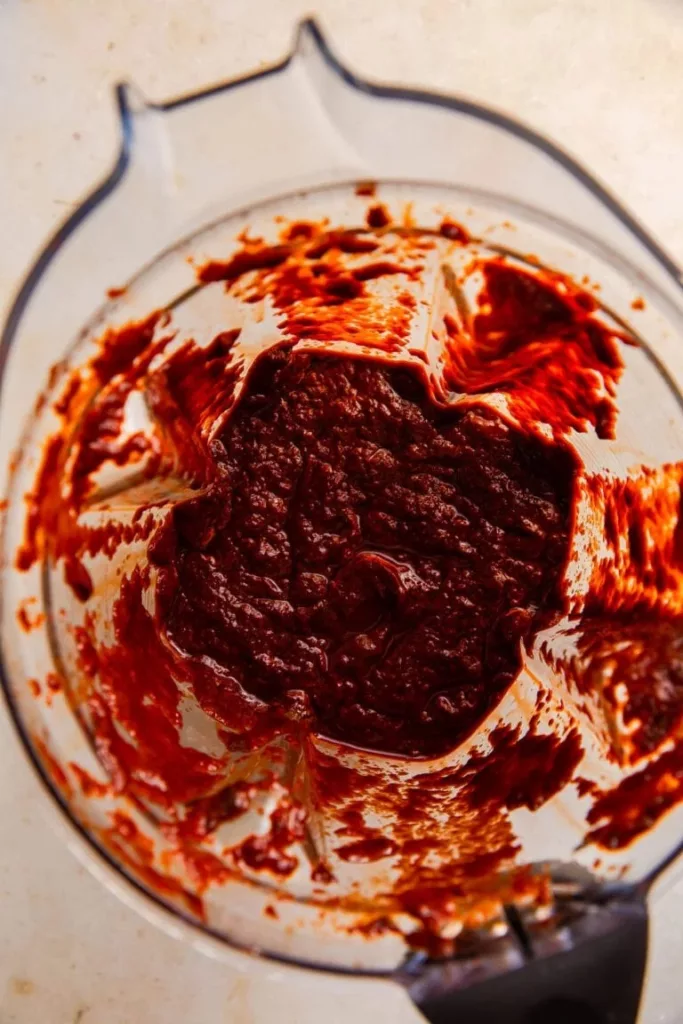
How To Make This Pozole Rojo Recipe
- Prepare the chilies by trimming the stems from the ancho and guajillo peppers. Next, empty each chile’s interior seeds into a big basin by shaking them out. Pour boiling water over the chiles, making sure they are well immersed, then let them to soak and rehydrate.
- Mix the chilies: Put the soaked chiles and one cup of the soaking liquid into the body of a powerful blender (I like my blender!) or food processor; do not throw out the leftover liquid. Process until the chiles are smooth, about 1 minute. If the mixture is too thick, add more liquid.

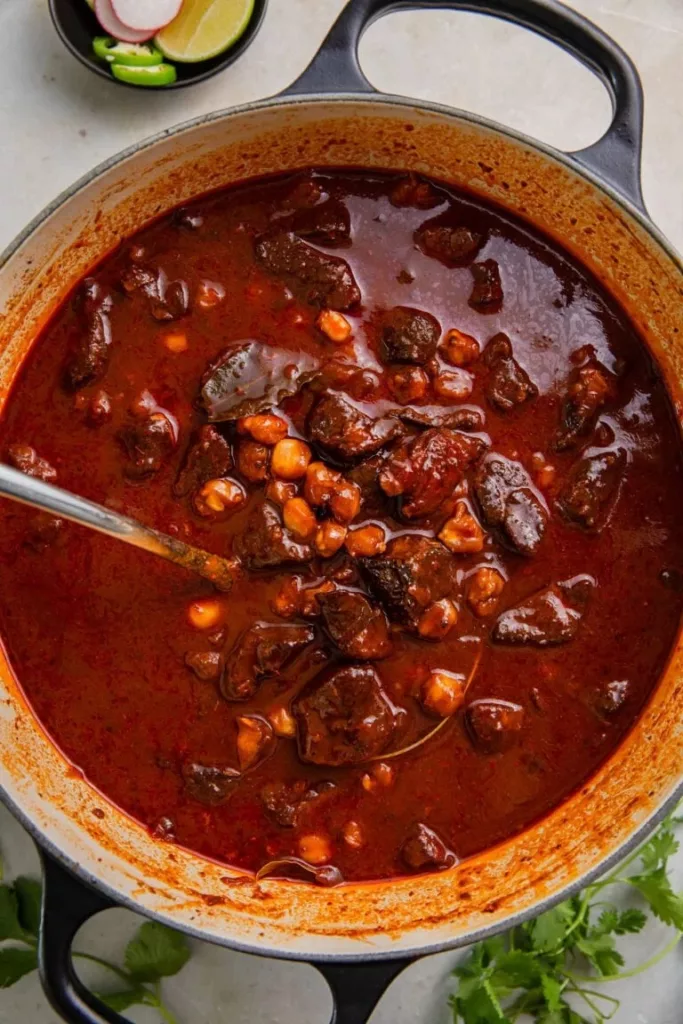
Brown The Pork & Build The Stew
- Toasted the pork. Add the oil to a large Dutch oven and heat it over medium-high heat. Add a few of the pork chunks to the saucepan in stages, being cautious not to pack it too full. Sear the pork for two to three minutes on each side, or until a good sear forms. Add salt and pepper to taste when preparing the meat. Once all of the pork is browned, transfer it to a fresh plate or small baking sheet and continue cooking. After that, turn down the heat to medium and save the browned pork bits.
- Heat up the aromatics: To the saucepan, add the chopped onion. Sauté for 3–4 minutes, or until the onions are soft. After that, add the garlic and simmer for a further minute or so, or until the combination becomes aromatic.
- To assemble the rojo pozole, add back the browned pork to the pot. Blend the chile combination and add it to the saucepan with the hominy, broth, bay leaves, cumin, oregano, and chipotle powder (if using). After thoroughly mixing, turn up the heat to medium-high and gently boil.
- Simmer: After lowering the heat to medium-low, simmer the stew for one and a half to two hours, stirring the pozole periodically, or until the pork is extremely soft.
- Serve: After the stew has simmered, remove the bay leaves, taste it, and adjust the seasoning with extra salt or pepper if needed. Spoon the rojo pozole into serving dishes, then garnish the stew with your preferred ingredients. Have fun!
Pozole Rojo Garnishes
When pozole rojo is served, people tend to add a lot of garnishes to the plate. Shredded cabbage, diced onions, sliced radish or jalapeños, cotija cheese, chopped avocado, lime wedges, and/or freshly chopped cilantro are some examples of these toppings. Each and every one of these garnishes gives the already excellent bowl of pozole a little bit more fullness and contrast. Fried corn tortilla strips and normal crumbled tortilla chips are also worthy of notice.

Tips + Tricks, FAQs & Recipe Notes
- Could I make this rojo pozole using beef? Absolutely! I suggest using beef chuck roast instead of pork. Cut the fat into bits and trim as necessary, then brown and braise the meat similarly to how pork shoulder is done. Hooray.
- Get your chilies toasty!- Before beginning the dish, roast your chiles for an added burst of flavor. To accomplish this, just spread the chiles out in a single layer on a medium-sized baking sheet. For about five minutes, roast the chiles in an oven preheated to 350°F. The chilies get more flavorful when they are toasted! Next, follow the instructions on the recipe card below to soak and prepare them.
Storing Leftover Pozole Rojo & Reheating:
Here’s how to prepare your pozole for refrigeration: First, ensure that the stew has cooled to room temperature. The pozole may then be kept in the refrigerator for up to four days if stored within an airtight container. Just warm everything up on the stovetop over low heat to reheat. As an alternative, reheat in the microwave until well heated.
Make sure the stew has cooled to room temperature before freezing your pozole. After that, pour the stew into a wide, flat plastic bag that is safe to freeze or an airtight container. To ensure it’s kept secure, I prefer to write the date on the stew’s label. The stew may be frozen for up to three months if you store it properly. Thaw pozole overnight in the refrigerator when ready. Just warm everything up on the stovetop over low heat to reheat. As an alternative, reheat in the microwave until well heated.
Slow Cooker Pozole Rojo:
Use the techniques listed in steps 1-4 of the recipe card below to prepare this pozole rojo in a slow cooker. Then, as mentioned in step 5, place everything into a sizable slow cooker pot (at least 6 quarts). Cook the pozole for 6–8 hours on low or 4–5 hours on high, stirring periodically. Then, as said in step 7, serve with the preferred toppings.
Instant Pot Pozole Rojo:
Use the identical techniques listed in steps 1 and 4 to prepare the chiles if you want to make this pozole rojo in a pressure cooker. As mentioned in stages 2-3, brown the pork and sauté the aromatics after setting the IP to the sauté mode. Next, assemble the stew following the instructions in step 5, making careful to add all of the ingredients to the pressure cooker without going over the liquid level. To seal, cover and shut. After setting the IP to pressure cook, let it cook for forty minutes. After that, open the IP till the steam stops. Then, to serve pozole with toppings, go to step 7.

Other cozy recipes you’ve gotta peep:
- Beef And Noodles Recipe
- Chicken Stew
- Vegetable Beef Soup
- Corned Beef and Cabbage Soup
- Authentic Cajun Gumbo
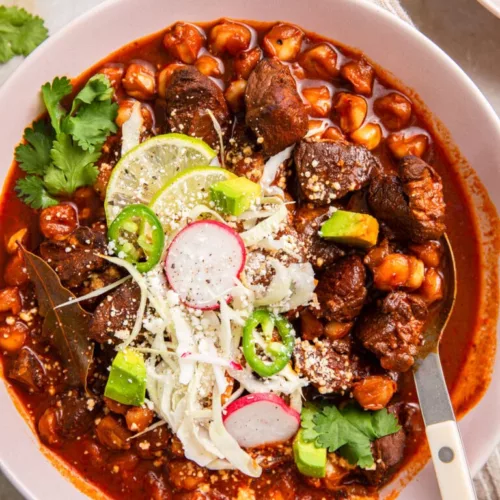
Pozole Rojo
Ingredients
- 4 dried guajillo chiles
- 4 dried ancho chiles
- 3 tablespoons olive oil
- 2 – 2 ½ lbs boneless pork shoulder trimmed of excess fat & then cut into rough chunks
- Kosher salt & freshly ground black pepper- to taste
- 1 medium yellow onion chopped
- 10 cloves of garlic finely minced or pressed
- 1 tablespoon ground cumin
- 1 tablespoon Mexican oregano or regular oregano
- 1 teaspoon chipotle powder- optional
- 2 bay leaves
- 2 25-ounce cans white hominy, rinsed & drained (I use Juanita’s)
- 8 cups 64 ounces chicken broth
For serving pozole rojo- optional:
- Thinly sliced cabbage sliced radish, sliced jalapeños, cotija cheese, chopped avocado, lime wedges & fresh chopped cilantro, as desired
Instructions
- Prepare the chilies by trimming the stems from the ancho and guajillo peppers. Next, empty each chile’s interior seeds into a big basin by shaking them out. Pour boiling water over the chiles, making sure they are well immersed, then let them to soak and rehydrate. Proceed with the recipe in the meanwhile.
- To brown the pork, put the oil in a large stockpot or Dutch oven and heat it to medium-high. When the saucepan is heated, slowly rotate it to coat the bottom equally. Add a few of the pork chunks to the saucepan in stages, being cautious not to pack it too full. Sear the pork for two to three minutes on each side, or until a good sear forms. Add salt and pepper to taste when preparing the meat. Once all of the pork is browned, transfer it to a fresh plate or small baking sheet and continue cooking. After that, turn down the heat to medium and save the browned pork bits.
- Add the chopped onion to the saucepan and sauté the aromatics. Sauté the onions for three to four minutes, stirring occasionally, or until they are soft. After that, add the garlic and simmer for a further minute or so, or until the combination becomes aromatic.
- Blend the chiles: Going back to the soaked chiles, add 1 cup of the soaking liquid and the soaked chiles to the body of a powerful blender or food processor; do not discard the remaining liquid. Process until the chiles are smooth, about 1 minute. If the mixture seems too thick, add a little more of the soaking liquid (or to help swish/clean out the blender/processor).
- To make the pozole rojo, add the pork back into the pot once it has browned and any accumulated juices. Blend the chile combination and add it to the saucepan with the hominy, broth, bay leaves, cumin, oregano, and chipotle powder (if using). After thoroughly mixing, turn up the heat to medium-high and gently boil.
- Sim-sima: Lower the heat to medium-low and simmer the stew for one and a half to two hours, stirring the pozole periodically, or until the pork is extremely soft and easily pulls apart.
- Serve: After the stew has simmered, remove the bay leaves, taste it, and adjust the seasoning with extra salt or pepper if needed. Spoon pozole rojo into serving bowls and garnish with shredded cabbage, sliced jalapeños or radish, cotija cheese, diced avocado, lime wedges, and/or freshly chopped cilantro, if preferred. Have fun!
Notes
- Slow Cooker Pozole: Use the exact directions listed in steps 1-4 of the recipe card to prepare this pozole rojo in a slow cooker. Then, as mentioned in step 5, place everything into a sizable slow cooker pot (at least 6 quarts). Cook the pozole for 6–8 hours on low or 4–5 hours on high, stirring periodically. Then, as said in step 7, serve with the preferred toppings.
- Instant Pot Pozole: To prepare the chiles for this pozole rojo, use a pressure cooker and the same methods as mentioned in stages 1 and 4. As mentioned in stages 2-3, brown the pork and sauté the aromatics after setting the IP to the sauté mode. Next, assemble the stew following the instructions in step 5, making careful to add all of the ingredients to the pressure cooker without going over the liquid level. To seal, cover and shut. After setting the IP to pressure cook, let it cook for forty minutes. After that, open the IP till the steam stops. Then, to serve pozole with toppings, go to step 7.
- Please read blog post in its entirety for more tips + tricks.
